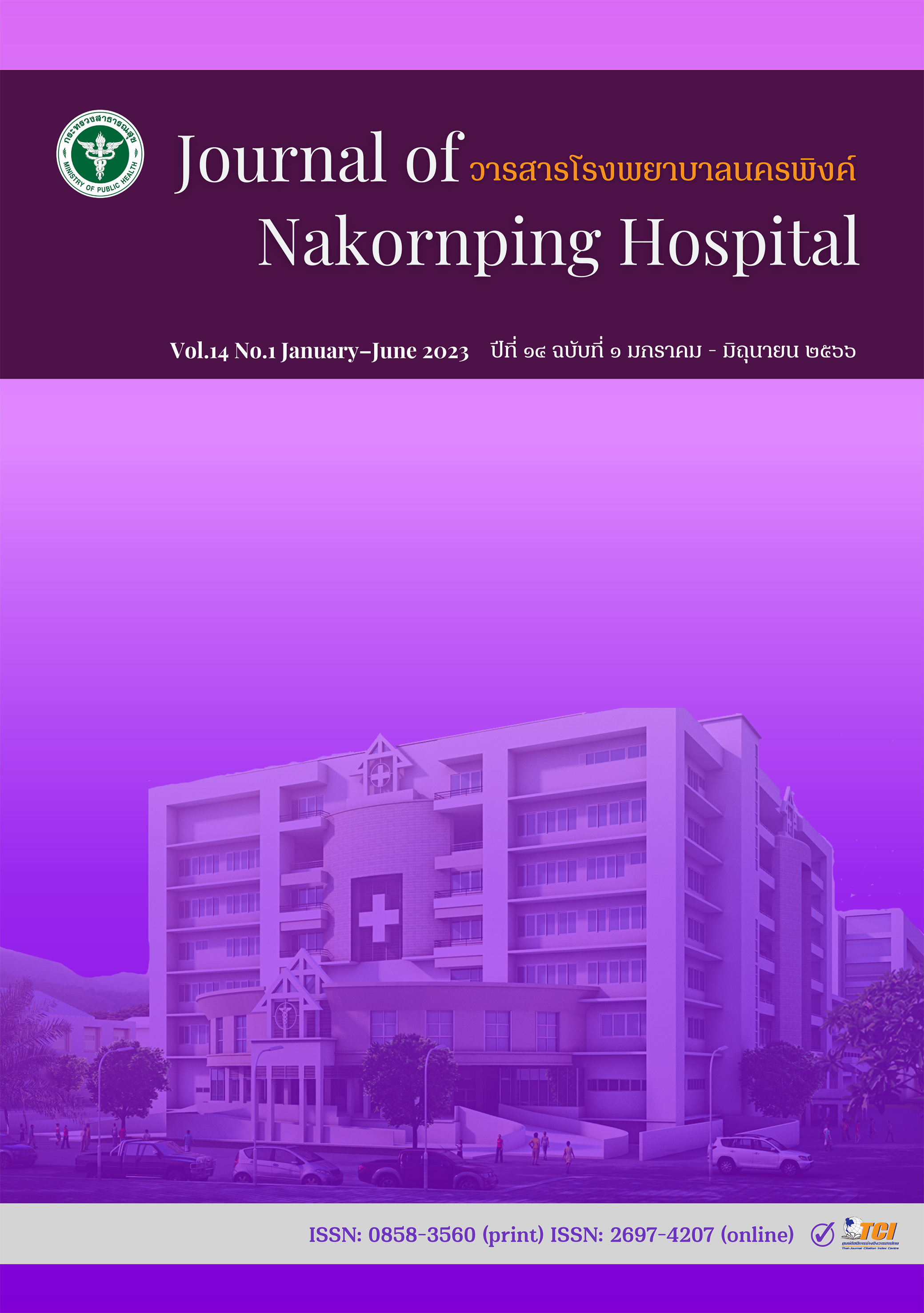The development of a professional nurse staffing management model for patient safety, Lamphun Hospital
Keywords:
professional nurse staffing management model, manpower management, nursing manpower, patient safetyAbstract
Objective: To study the situation of professional nurse staffing management, develop and evaluate the outcomes of the professional nurse staffing management model on patient safety at Lamphun Hospital.
Methodology: This study was a participatory action research design. The research was conducted from September 2565 to February 2566. The sample group consisted of 22 nurse administrators and 288 professional nurses. The research tools used were: (1) Tools for implementing the research, including guidelines for managing professional nurse staffing to ensure patient safety, and (2) Tools for data collection, including surveys and focus group discussions on the situation of staffing management, questionnaires on the perceptions of professional nurses towards the model, questionnaires on the roles of professional nurses in drug administration for patient safety, and satisfaction questionnaires towards the model. Quantitative data were analyzed using descriptive statistics, while qualitative data were analyzed using content analysis.
Results: The professional nurse staffing management model for patient safety consisted of three components: Component 1: Policy formulation for professional nurse staffing management, Component 2: Establishment of a professional nurse staffing management committee, and Component 3: Methods of professional nurse staffing management. The outcomes of the model revealed that the majority of nursing units were able to implement the model, as accepted by professional nurses (mean 3.86 ± 0.41), which helped reduce incidents related to patient safety. Professional nurses were able to effectively manage drug administration at a high level (mean 4.18 ± 0.43), and finally, there was a high level of satisfaction with the model (mean 4.19 ± 0.33).
Conclusion: The developed model contributes to the development of an appropriate professional nurse staffing management system, reduces incidents related to patient safety, and enables professional nurses to manage medications safely for patients.
References
Sawaengdee K. The Current Nursing Workforce Situation in Thailand. Journal of Health Systems Research. 2008;2(1):40-6. [In Thai]
Srisuphan W, Sawangdee K. Policy proposals to solve the shortage of registered nurses in Thailand. Journal of the Nursing Council. 2012;27(1):5-12. [In Thai]
Ministry of Public Health, Office of Policy and Strategy. Public Health Resource Information Report 2020. Bangkok: Health Information Group, Strategy and Planning Division; 2020. [In Thai]
Thailand Nursing and Midwifery Council. Policy information and directions for nursing personnel development shortages and medical care [Internet]. Nonthaburi: Thailand Nursing and Midwifery Council; 2021 [cited 2022 Dec 20]. Available from: https://www.tnmc.or.th/news/723 [In Thai]
Supamanee T, Kunaviktikul W, Keitlertnapha P. Nurses’ Extended Work Hours and Nurse Outcomes in Community Hospitals. Nursing Journal CMU. 2014;41(Special Edition):48-58. [In Thai]
Scott LD, Rogers AE, Hwang WT, Zhang Y. Effects of critical care nurses' work hours on vigilance and patients' safety. Am J Crit Care. 2006 Jan;15(1):30-7.
Hfocus. Ministry of Public Health, Public Health requires all affiliated hospitals to be HA-quality hospitals - move forward with 2P safety [Internet]. Udonthani: Hfocus; 2019 [cited 2022 Dec 20]. Available from: https://www.hfocus.org/content/2019/03/16965. [In Thai]
Ministry of Public Health, Office of the Permanent Secretary. Determining the appropriate duration of medical personnel. Nonthaburi: Office of the Permanent Secretary; 2019. [In Thai]
Boonthong T. Policy on working hours of nurses on patient safety, announced on April 17, 2017 [Internet]. Bangkok: Thailand Nursing and Midwifery Council; 2017 [cited 2022 Dec 22]. Available from: https://www.tnmc.or.th/images/userfiles/files/H002.pdf. [In Thai]
Jaikong N, Thammapreecha J, Siriprasertchok R, Pimoljinda T. Management Policy and the Shortage of Professional Nurses. Hatyai Academic Journal. 2020;18(2):241-59. [In Thai]
Lamphun Hospital. Risk and safety reports to patients Lamphun Hospital 2021. Lamphun: Lamphun Hospital; 2021. [In Thai]
Nursing Council. Nursing drug administration. Bangkok: Nursing Council; 2019. [In Thai]
Srisathitnarakoon B. Development and verification of research instruments: psychological measurement features. Bangkok: Chulalongkorn University Press; 2013. [In Thai]
Womack JP, Jones DT. Lean thinking. New York: Simon & Schuster; 2003.
Charoenwanying L, Kooha T. Model development of public health manpower planning according to service organization. Nonthaburi: Research report Strategy and Planning Division Office of the Permanent Secretary, Ministry of Public Health; 2020.
Nantsupawat R, Wichaikhum O, Nantsupawat A. The Relationship between Nurses’ Extended Work Hours and Patient, Nurse, and Organizational Outcomes in General Hospital. Nursing Journal CMU. 2014;41(4):58-69. [In Thai]
Sathira-Angkura T, Jamsomboon K, Wongsuvansir S, Leelawong S, Boonkaew H. Development of Nursing Manpower Management Model for Patient Safety: a Pilot Study in Ratchaburi Province. Journal of Health Science. 2019;28(6):1130-42. [In Thai]
Downloads
Published
How to Cite
Issue
Section
License
Copyright (c) 2023 Nakornping Hospital

This work is licensed under a Creative Commons Attribution-NonCommercial-NoDerivatives 4.0 International License.
The articles that had been published in the journal is copyright of Journal of Nakornping hospital, Chiang Mai.
Contents and comments in the articles in Journal of Nakornping hospital are at owner’s responsibilities that editor team may not totally agree with.



